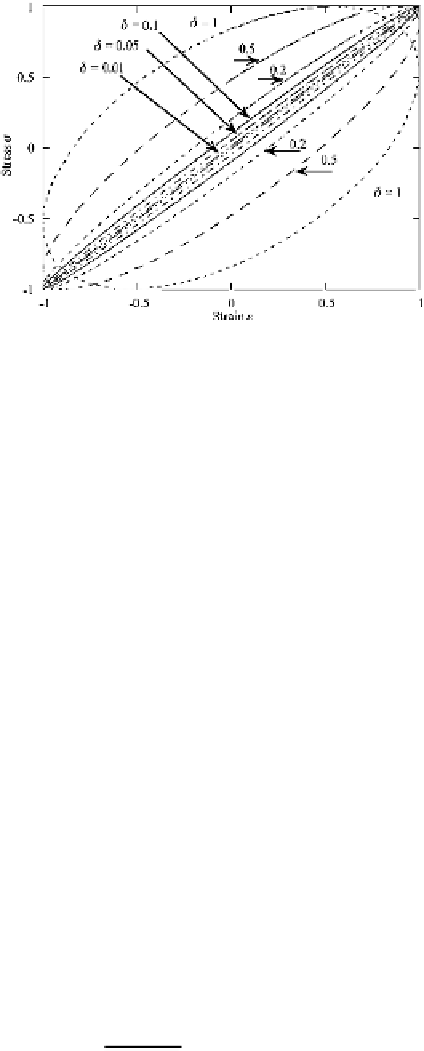Biomedical Engineering Reference
In-Depth Information
Fig. 6.15
Example of
stress-strain curves with
slopes and intercepts for a
linear viscoelastic material
under oscillatory load, e.g.
viscoelastic rubber
relaxation studies and is referred to as a Cole-Cole plot [
80
]. A single relaxation-
time process gives a semicircle in a Cole-Cole plot. Another usual graphical repre-
sentation is that of stiffness versus loss:
E
∗
|
versus tan
δ
, i.e. a stiffness-loss map.
In the remainder of this section, we shall focus our attention on the loss tangent
and its relation to hysteresis loops. Consider again the relation between stress and
strain in dynamic loading of a linearly viscoelastic material. First, the shape of the
stress-strain curve is determined, and a relation for the loss tangent is developed.
Hitherto, we have considered stress and strain as they depend on time. Suppose we
have
|
ε
=
B
sin
ωt
(6.56)
and
σ
=
D
sin
(ωt
+
δ)
(6.57)
which determine an elliptic Lissajous as given in Fig.
6.15
, the direct consequence
of linearly viscoelastic behavior. For some materials, the curve of stress versus strain
in dynamic loading is not elliptical, but has pointed ends; this behavior is a mani-
festation of material nonlinearity. The loop is called a hysteresis loop. Hysteresis, in
general, refers to a lag between cause and effect. In some contexts, such as the study
of polymers, a specific view of hysteresis is taken; it then represents a frequency-
independent damping, as discussed in the next chapter. To interpret the dimensions
and intercepts of the figure, first let the intersection with the axis be called
A
,as-
sumed to occur at time
t
1
. Then, consider
A
=
B
sin
ωt
1
and
0
=
D
sin
(ωt
1
+
δ)
=
D
sin
(ωt
1
)
cos
δ
+
D
cos
ωt
1
sin
δ
(6.58)
B
√
B
2
A
B
1
A
2
Substituting sin
ωt
1
=
and cos
ωt
1
=
−
into the last expression, we
obtain
B
2
D
A
D
B
=
+
−
A
2
sin
δ
0
B
cos
δ
(6.59)
Squaring the last expression leads to
A
2
cos
2
δ
B
2
sin
2
δ
A
2
sin
2
δ
, hence
=
−
A
2
(
cos
2
δ
sin
2
δ)
B
2
sin
2
δ
. This implies that sin
δ
A
+
=
=
B
.If
ωt
=−
δ
, then
σ
=
0.



